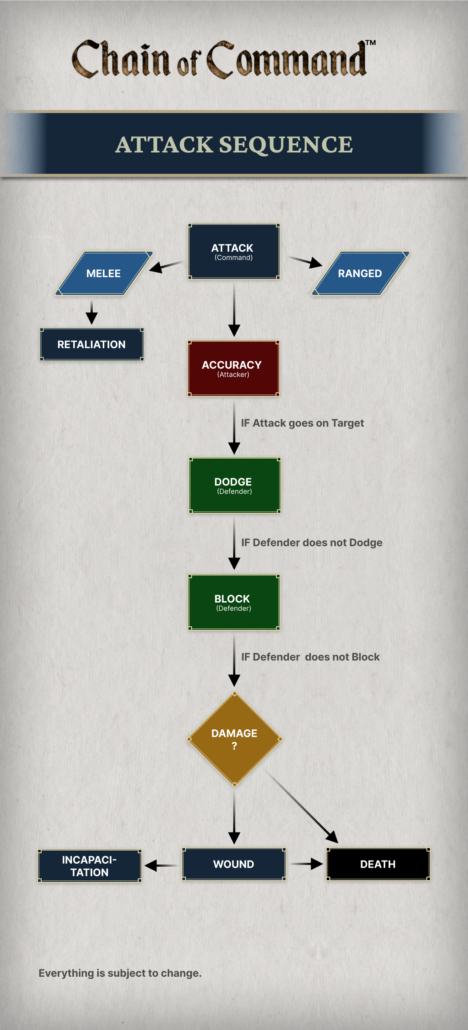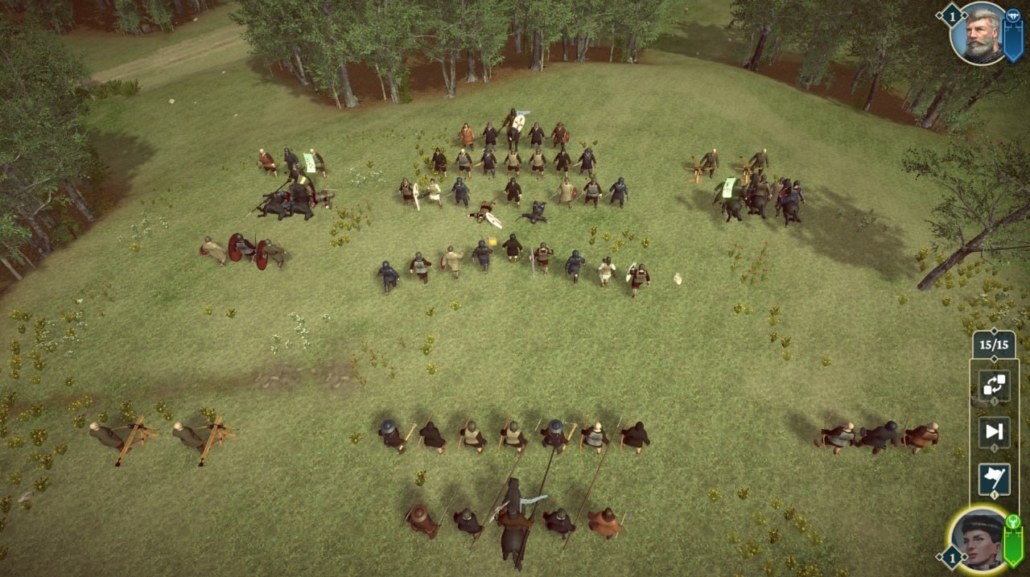Medieval Art of War: The Attack Sequence in Chain of Command™ Explained
Welcome to the blood-soaked, morale-crushing world of our medieval strategy game. Combat in Chain of Command (CoC) isn’t always a heroic fight of knights in shining armor. It’s more like: “Fear not my brave warriors, we can always outrun them.” Or “Sorry Aedwulfrith, I did not stab you in the back on purpose.”
Note: In Chain of Command each Battle has multiple Phases and Combat is only one of them. Pre- and Post- Combat phases and Combat itself will be explained painfully detailed in different articles. Attack in CoC is the concept of one unit or army formation attacking another unit or army formation. Therefore each Combat holds multiple Attacks that run their own Attack Sequence.
In our historically accurate medieval strategy game, the Attack Sequence governs how attempt to unalive someone unfolds. We balance realism with CoC’s focus on morale-based victories, permadeath, and lasting injuries. In this post we break down the system clearly, with a touch of dark humor to keep you awake.

Attack Sequence Chart – Chain of Command
Attack Command – Starting the Attack Sequence
The Attack Command initiates fighting, setting the stage for chaos:
- It defines the Attacker and Defender – and there is a good chance one of them will regret their role later.
- While you command your army down to the company level – your units will find their own targets to attack (or run away from). You do not micromanage those pesky peasants – it would be beneath a person of a noble stature as you are.
- Melee attacks trigger Retaliation if Defender can fight back. Defender won’t wait for the Attacker to hit them first – if they are faster, they can drop the Attacker before they even throw a swing.
- Ranged attacks come in two flavors:
- Direct Fire: Straight shots (e.g., bows, crossbows or slings) have full accuracy and penetration, but shorter range.
- Indirect (Arc) Fire: Arcing shots (e.g., bows or catapults) have longer range but reduced accuracy, damage, and penetration.
- Some Ranged weapons have only one fire mode.
- Weapons that can use both fire modes will use indirect fire only if direct fire is blocked or are explicitly commanded to do so.
Accuracy – Danger or Distraction?
Accuracy determines if your attack lands or flops:
- Aimed Attack (Melee & Direct Fire): Combines Unit Accuracy and Weapon Accuracy. Example: a unit with 87% accuracy, with a weapon of 76% accuracy has an 87% x 76% = 66% hit chance.
- Area Attack (Indirect Fire): Factors in Unit Density in a 3×3 grid around the target. If there is only one unit in the 3×3 grid around the Target unit (33.4% density), the accuracy of the Attacker from the previous example drops to 22%, or – to say it straight, you have 78% chance to donate arrows to the opponent.
Dodge – Are we Dancing or Fighting?
If Accuracy gods are in your favor, the opponent does not need to just stand there and take it. If they are nimble enough they can dodge the attack and repay you in kind while you are swirling around.
Only Melee attacks can be dodged. Defenders have a basic Dodge Stat, but it goes down with the weight they carry – though most warriors prefer a good breastplate from ballet lessons. Except for that cowardly cousin Quentin, of course.
Hit Areas – Will It Hurt?
If the attack lands, the Hit Areas of the body define if the poor sod you just impaled has a higher chance of meeting their maker or limping back home:
- Ranged Hit Areas take in account that Attacker will aim at the center mass, or shoot in the general direction, therefore the chance to hit any body part is equal to the size of it with slight preference of hitting the torso.
- Melee Hit Areas are more deliberate and try to hit where it counts – mostly the head and the torso.
Block – Last Line of Defense
The Block Check is the Defender’s final stand in mitigating the damage (sometimes literally):
- Weapon Block: Some weapons are good at parrying melee or rarely missile attacks. Weapon Block deflects the Attack.
- Shield Block: Shields are a great counter for melee and ranged attacks – maybe that is why almost every warrior in history had one. But Shields can break or get penetrated by forceful attacks – though in such case attack’s force will be significantly reduced.
- Armor Block: A passive defense. More armor makes sure your unit’s squishy flesh does not get punctured. But even the best armor has some weak points that can be found by a lucky (or unlucky – depending if you are on the supplying or receiving end) hit. If armor takes a hit there is still a chance it will get penetrated. In such a case armor will mitigate a lot of damage – but some will get through. And in case of the Attack hitting where it was intended, well, you should pray before going into Battle.
Why Attack Sequence Matters
This system is brutally historically accurate. Say, despite the best armor of the time, king Harold caught an arrow in the eye (probably) at Hastings. And so Brits had to start learning French. If he had better luck at rolling Block dice the world would be different. Maybe French would have to learn how to spell instead of just randomly placing letters in the words.
Chain of Command is not for the faint-hearted save scummers, sore losers and participation medal activists. Our game will give you the experience of medieval life: it was not fair, it did not care about your feelings and it would probably end your miserable existence before you could spell counterdisestablishmentarianism.
But if that is what you were looking for – Chain of Command™ – the game that makes you enjoy the life frustrations of a medieval noble has it all for you. Click here to Enlist for Chaos!

Battle – Chain of Command – early game development footage


